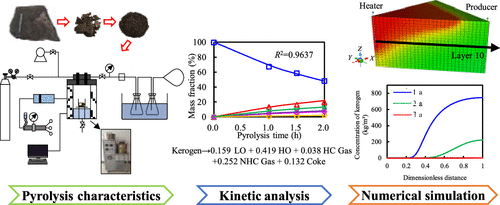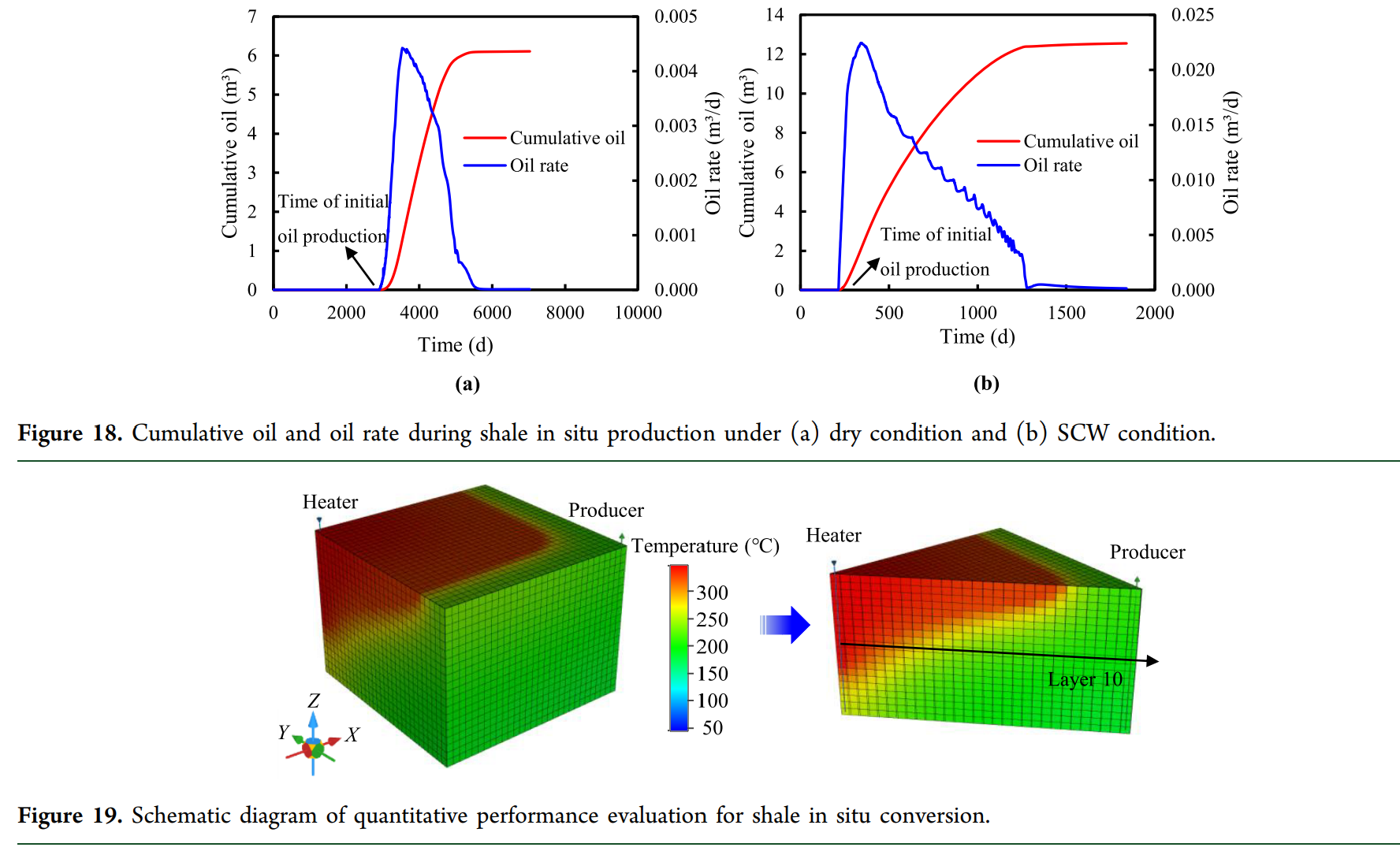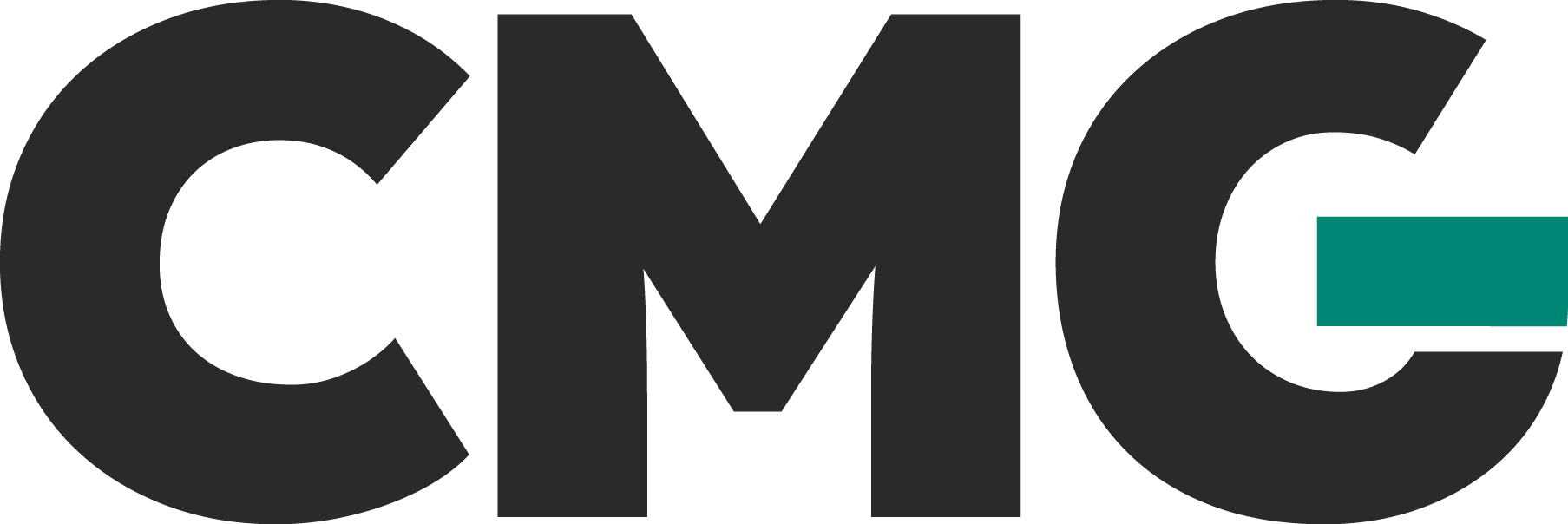Pyrolysis Mechanism and Reservoir Simulation Study of Organic-Rich Shale during the In Situ Conversion via Supercritical Water Heating
低成熟度至中等成熟度的页岩气藏因其巨大的储量和油气生成潜力而受到广泛关注。本文创建了一种自设计的高温高压热解实验装置,对来自龙口页岩的样品进行了热重热解和超临界水(SCW)环境中的等温热解实验。通过比较SCW环境与干燥环境下页岩热解产物的特性,理解了SCW对富含有机质页岩热解的影响。利用非线性最小二乘法拟合热解产物的组成特性,建立了干环境和SCW环境下干酪根热解的完整动力学模型。研究了通过SCW注入和电加热进行页岩原位转化的数值模拟,并阐明了热反应流耦合的性能演变。
结果表明,SCW降低了干酪根热解的主要温度窗口,总质量损失比干燥环境增加了46.29%。SCW促进了热解烃类的生成和随后的释放。SCW通过增加热解气体中的CO2含量、减少烯烃含量,并与干燥环境相比有效提高了油品质。SCW将干酪根热解的活化能降低了41.65%,表明反应更容易激活。生成了更多的烃类产物和更少的焦炭。动力学模型的优越性对SCW加热富含有机质页岩原位转化技术的应用具有重要的实际意义。通过SCW进行的页岩原位转化大大缩短了生产周期并提高了累积油产量。井间区域的干酪根完全热解,储层孔隙度增加到原始值的2倍,渗透率在3年后通过SCW原位转化增强了10倍。
CMG软件应用情况:
本文利用CMG公司的STARS模块建立了数值模拟模型,主要研究了SCW注入和电加热过程中页岩原位转化的热反应流耦合性能演变。模拟基于典型的五点井型模式的四分之一进行,域被离散化为30×30×20的笛卡尔网格块,尺寸为0.25×0.25×0.25米。模拟模型考虑了干酪根分解和固体组分生成对页岩气藏孔隙度和渗透率的影响,并应用了Carmen Kozeny方程来描述渗透率对孔隙度的依赖性。


Abstract
The low-medium maturity shale reservoir has garnered substantial interest because of its huge reserves and promising hydrocarbon generation potential. In this paper, a self-designed high-temperature and pressure pyrolysis experiment device was constructed. Experiments involving thermogravimetric pyrolysis and isothermal pyrolysis in supercritical water (SCW) environments were carried out on samples from the Longkou shale. The effect of SCW on organic-rich shale pyrolysis was understood by comparing the product characteristics of shale pyrolysis in SCW environments with dry environments. The complete kinetic models of kerogen pyrolysis in dry and SCW environments were established by fitting the composition characteristics of pyrolysis products using the nonlinear least-squares method. The numerical simulation of shale in situ conversion via SCW injection and electrical heating was investigated, and the performance evolution of thermal-reactive flow coupling was clarified. The results showed that SCW reduced the main temperature window of kerogen pyrolysis, and the total mass loss increased by 46.29% compared to that in a dry environment. SCW promoted the generation and subsequent release of pyrolysis hydrocarbons. SCW altered the compositional profile of the generated products, mainly by increasing CO2 content in pyrolysis gas, reducing olefin content, and effectively improving oil quality compared with the dry environment. SCW reduced the activation energy of kerogen pyrolysis by 41.65%, indicating that the reaction is more easily activated. More hydrocarbon products and less coke were generated. The superiority of kinetic models holds significant practical implications for the application of SCW heating organic-rich shale in situ conversion technology. The shale in situ conversion via SCW greatly shortened the production cycle and improved cumulative oil. Kerogen within the interwell region was completely pyrolyzed, the reservoir porosity increased to 2 times of the original value, and permeability was enhanced by 10 times after shale in situ conversion via SCW for 3 years.
作者单位:
中国石油大学(华东)石油工程学院,深层油气国家级实验室,教育部非常规油气开发重点实验室
